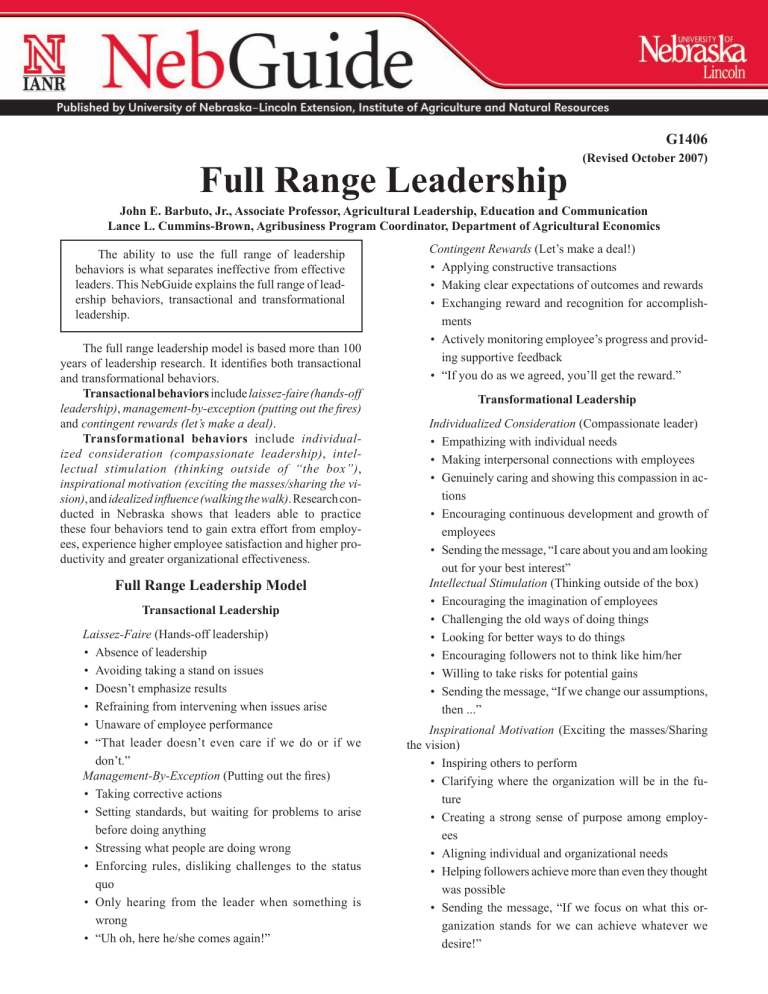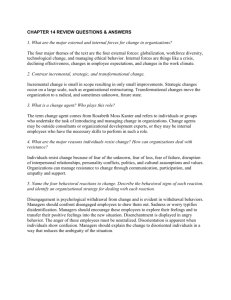Full Range Leadership - University of Nebraska–Lincoln

G1406
(Revised October 2007)
Full Range Leadership
John E. Barbuto, Jr., Associate Professor, Agricultural Leadership, Education and Communication
Lance L. Cummins-Brown, Agribusiness Program Coordinator, Department of Agricultural Economics
The ability to use the full range of leadership behaviors is what separates ineffective from effective leaders. This NebGuide explains the full range of leadership behaviors, transactional and transformational leadership.
Contingent Rewards (Let’s make a deal!)
• Applying constructive transactions
• Making clear expectations of outcomes and rewards
• Exchanging reward and recognition for accomplishments
• Actively monitoring employee’s progress and providing supportive feedback
• “If you do as we agreed, you’ll get the reward.”
The full range leadership model is based more than 100 years of leadership research. It identifies both transactional and transformational behaviors.
Transactional behaviors include laissez-faire (hands-off leadership) , management-by-exception (putting out the fires) and contingent rewards (let’s make a deal) .
Transformational behaviors include individualized consideration (compassionate leadership) , intellectual stimulation (thinking outside of “the box”) , inspirational motivation (exciting the masses/sharing the vision) , and idealized influence (walking the walk)
. Research con- ducted in Nebraska shows that leaders able to practice these four behaviors tend to gain extra effort from employees, experience higher employee satisfaction and higher productivity and greater organizational effectiveness.
Full Range Leadership Model
Transactional Leadership
Laissez-Faire (Hands-off leadership)
• Absence of leadership
• Avoiding taking a stand on issues
• Doesn’t emphasize results
• Refraining from intervening when issues arise
• Unaware of employee performance
• “That leader doesn’t even care if we do or if we don’t.”
Management-By-Exception
(Putting out the fires)
• Taking corrective actions
• Setting standards, but waiting for problems to arise before doing anything
• Stressing what people are doing wrong
• Enforcing rules, disliking challenges to the status quo
• Only hearing from the leader when something is wrong
• “Uh oh, here he/she comes again!”
Transformational Leadership
Individualized Consideration (Compassionate leader)
• Empathizing with individual needs
• Making interpersonal connections with employees
• Genuinely caring and showing this compassion in actions
• Encouraging continuous development and growth of employees
• Sending the message, “I care about you and am looking out for your best interest”
Intellectual Stimulation (Thinking outside of the box)
• Encouraging the imagination of employees
• Challenging the old ways of doing things
• Looking for better ways to do things
• Encouraging followers not to think like him/her
• Willing to take risks for potential gains
• Sending the message, “If we change our assumptions, then ...”
Inspirational Motivation (Exciting the masses/Sharing the vision)
• Inspiring others to perform
• Clarifying where the organization will be in the future
• Creating a strong sense of purpose among employees
• Aligning individual and organizational needs
• Helping followers achieve more than even they thought was possible
• Sending the message, “If we focus on what this organization stands for we can achieve whatever we desire!”
Passive
LF
Effective
IC
IS
IM
II
MBE
CR
Active
Ineffective
Idealized Influence
(Actions speak louder than words)
• Demonstrating an inclusive vision
• Walking the walk
• Exhibiting great commitment and persistence in pursuing objectives
• Expressing confidence in the vision of the organiza
tion
• Developing trust and confidence among employees
• Symbolizing the goals and mission of the organization
• Sending the message, “I believe that this is truly the right thing to do”
The chart above illustrates the full range of leadership behaviors. Laissez-faire (LF) is the most inactive and generally least effective of the leader behaviors. Research shows that leaders using this style of leadership are rarely viewed as effective on the job. Management-by-exception (MBE) is more effective than laissez-faire, but is generally ineffective leadership.
Management-by-exception behavior often is related to high employee turnover and absenteeism, poor satisfaction and poor perception of organizational effectiveness. Contingent rewards (CR) can be an effective style of leadership. However, leaders will not get more than they bargain for when practicing this style of leadership.
It is only with the remaining four behaviors that leaders are able to motivate followers to perform above expectations and transcend their own self-interest for the sake of the organization. The four — individualized consideration (IC), intellectual stimulation (IS), inspirational motivation (IM), and idealized influence (II) — all have resulted in extra effort from workers, higher productivity, higher morale and satisfaction, higher organizational effectiveness, lower turnover, lower absenteeism and greater organizational adaptability to changes in the environment.
Based on these findings, leaders are generally most effec
tive when they regularly use each of the four transformational behaviors (individualized consideration, intellectual stimulation, inspirational motivation and idealized influence) to build on contingent rewards.
Sources of Data
Leadership Development Extension Leadership Workshops Conducted by John E. Barbuto, Jr. throughout the State of Nebraska, from July 1997 to July 1999.
Bass, B. M. (1990). Bass’ and Stogdill’s Handbook of leadership. New York: Free Press.
Bass, B. M., and Avolio, B. J. (1994). Improving organizational effectiveness through transformational leadership.
Thousand Oaks, CA: Sage Publications.
UNL Extension publications are available online at http://extension.unl.edu/publications .
Index: Consumer Education
Consumer Information—General
2000, Revised October 2007
Extension is a Division of the Institute of Agriculture and Natural Resources at the University of Nebraska–Lincoln cooperating with the Counties and the United States Department of Agriculture.
University of Nebraska–Lincoln Extension educational programs abide with the nondiscrimination policies of the University of Nebraska–Lincoln and the United States Department of Agriculture.
© 2000-2007, The Board of Regents of the University of Nebraska on behalf of the University of Nebraska–Lincoln Extension. All rights reserved.





